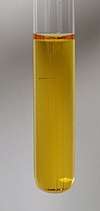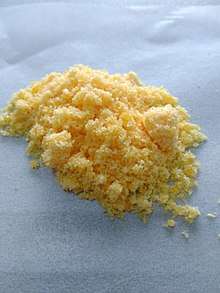Cyanonickelate
The cyanonickelates are a class of chemical compound containing anions consisting of nickel atoms, and cyanide groups. The most important of these are the tetracyanonickelates containing four cyanide groups per nickel. The tetracyanonickelates contain the [Ni(CN)4]2− anion. This can exist in solution or in solid salts. The ion has cyanide groups arranged in a square around the central nickel ion. The symmetry of the ion is D4h. The distance from the nickel atom to the carbon is 1.87 Å, and the carbon-nitrogen distance is 1.16 Å.[1] Tetracyanonickelate(II) can be oxidised electrochemically in solution to yield tetracyanonickelate(III) [Ni(CN)4]−. [Ni(CN)4]− is unstable and Ni(III) oxidises the cyanide to cyanate OCN−.[2] Tetracyanonickelate(III) can add two more cyanide groups to form hexacyanonickelate(III).[2]
-3D-balls.png)


In combination with alkyldiamines, and other metal ions, tetracyanonickelate ions can form cage structure that can accommodate organic molecules. This is a Hofmann-diam-type clathrate.[3]
If the cation is a very strong reducing agent, such as Yb2+, [Ni(CN)4]2− can be reduced to [Ni2(CN)6]4− where nickel atom is in the +1 oxidation state.[4]
| formula | name | Ni Ox | structure | Remarks | references |
|---|---|---|---|---|---|
| Na2[Ni(CN)4]·3H2O | disodium tetracyanonickelate(II) | 2 | triclinic a = 7.392 Å, b = 8.895 Å, c = 15.11 Å , α = 89.12, β= 87.46, γ = 84.54° Z=4 V=988 Å3 FW=262.81 | orange; Ni(CN)4 planes parallel | [5][6] |
| K2[Ni(CN)4]·H2O | potassium tetracyanonickelate(II) | 2 | monoclinic | orange-red; dehydrate at 110° | [7] |
| K2[Ni(CN)4] | potassium tetracyanonickelate(II) | 2 | monoclinic a=4.294 Å, b=7.680 Å, c=13.02 Å, β=87°16′ | orange-yellow; CN forms a square around Ni | [7] |
| Ca[Ni(CN)4]·5H2O | calcium tetracyanonickelate(II) | 2 | orthorhombic Pcab a=18.18 Å, b=18.86 Å, c=6.774 Å, Z=8, V=2195 Å3, density=1.774 | CN forms distorted square around Ni; yellow when light polarized in elongation direction, colourless ⊥ | [8] |
| Co·2H2O[Ni(CN)4]·4H2O | diaquacobalt tetracyanonickelate tetrahydrate | 2 | orthorhombic a=12.178 Å, b=13.885 Å, c=7.143 Å, V=1207.8 Z=4 | Orange MW=329.82 | [9] |
| Ni(NH3)2[Ni(CN)4]·C6H6 | Hofmann clathrate | 2/2 | benzene can be replaced by some other aromatic hydrocarbons; octahedral nickel can be replaced by Mn, Fe, Co, Cu, Zn or Cd. The square planar nickel can be replaced by Pd or Pt. Ammonia can be replaced by diamines and amines. | [10] | |
| Rb2[Ni(CN)4]·H2O | rubidium tetracyanonickelate(II) | 2 | triclinic P1 a=8.602 Å, b=9.693 Å, c=12.006 Å, α = 92.621°, β= 94.263∘, γ =111.79° V=924.0 Å3 | orange needles; Ni(CN)4 planes parallel; water in 5% excess | [6] |
| Sr[Ni(CN)4]·5H2O | strontium tetracyanonickelate(II) | 2 | monoclinic C2/m, a=10.356 Å, b=15.272 Å, c=7.133 Å, α=98.55°, V=1115.6 Å3 | orange; Ni(CN)4 planes parallel | [6] |
| Cd·2H2O[Ni(CN)4]·4H2O | diaquacadmium tetracyanonickelate tetrahydrate | 2 | orthorhombic Pnma, a = 12.393 Å, b = 14.278 Å, c = 7.427 Å, Z = 4, V=1314 Å3, density=1.937 | MW=383.27 | [10] |
| Cs2[Ni(CN)4]·1.05H2O | Cesium tetracyanonickelate(II) | 2 | hexagonal, P61, a = 9.526 Å, c = 19.043 Å, V = 1496.5 Å3 Z=6 | golden yellow; Ni(CN)4 planes arranged in a spiral | [11] |
| CsKNi(CN)4 | cesium potassium tetracyanonickelate | 2 | triclinic a= 7.421 Å, b= 8.626 Å, c= 9.364 Å, α= 60.64°,β= 70.88°, y= 70.88°, and Z= 2. den=2.55 | orange | [12] |
| Ba[Ni(CN)4]·4H2O | barium tetracyanonickelate(II) | 2 | monoclinic | red | [13] |
| (dmf)4EuNi(CN)4 | Europium(II) tetracyanonickelate | 2 | triclinic P1̄, a=8.902Å, b=10.947Å, c = 12.464Å, α = 82.99°, β = 86.86°, γ = 84.92°, Z = 2 | [4] | |
| Tl2[Ni(CN)4]·1.05H2O | Thallium(I) tetracyanonickelate | 2 | monoclinic a=6.154 b=7.282 c=9.396 β=104.29 V=408.0 Z=2 density=4.652 | bright yellow orange; chains of TlNi | [12] |
| (UO2)2(dmso)4(OH)2[Ni(CN)4] | 2 | monoclinic C2/c a=21.522 Å, b=10.2531 Å, c=13.3170 Å, β=111.943° V=2725.8 Å | yellow | [14] | |
| K4[(CN)2Ni(CN)2Ni(CN)2] | potassium tetracyano-µ-dicyanonickelate(I) | 1 |
References
- Loewenschuss, A.; Marcus, Y. (1996). "Standard Thermodynamic Functions of Some Isolated Ions at 100–1000 К" (PDF). J. Phys. Chem. Ref. Data. 25 (6): 1502. Bibcode:1996JPCRD..25.1495L. doi:10.1063/1.555990. Retrieved 30 April 2016.
- Wang, Yi Lai; Beach, Mark W.; Pappenhagen, Thomas L.; Margerum, Dale W. (November 1988). "Mixed-ligand complexes of tetracyanonickelate(III) and dynamic Jahn-Teller distortions of hexacyanonickelate(III)". Inorganic Chemistry. 27 (24): 4464–4472. doi:10.1021/ic00297a025.
- Şenyel, Mustafa; Raci Sertbakan, T.; Kürkçüoğ, Güneş; Kasap, Ergün; Kantarci, Ziya (2001). "An Infrared Spectroscopic Study on the Hofmann-diam-type 1,12-Diaminododecanemetal(II) Tetracyanonickelate(II)-aromatic Guest Clathrates: M(H2N(CH2)12NH2)Ni(CN)4·G (M = Co, Ni or Cd; G = Benzene, Naphthalene, Anthracene, Phenanthrene or Biphenyl)". Journal of Inclusion Phenomena and Macrocyclic Chemistry. 39 (1/2): 175–180. doi:10.1023/A:1008141726024.
- Knoeppel, David W.; Shore, Sheldon G. (January 1996). "Unusual One-Dimensional Ladder Structures Containing Divalent Europium and the Tetracyanometalates Ni(CN)4 and Pt(CN)4". Inorganic Chemistry. 35 (18): 5328–5334. doi:10.1021/ic960337v.
- Ptasiewicz-Bak, H.; Olovsson, I.; McIntyre, G. J. (1 October 1998). "Structure, Charge and Spin Density in Na2Ni(CN)4·3H2O at 295 and 30 K". Acta Crystallographica Section B. 54 (5): 600–612. doi:10.1107/S0108768198002286.
- Fronczek, Frank R.; Delord, Terry J.; Watkins, Steven F.; Gueorguieva, Petia; Stanley, George G.; Zizza, Annegret S.; Cornelius, Jeffrey B.; Mantz, Yves A.; Musselman, Ronald L. (November 2003). "A Solid-State Spectral Effect in Eclipsed Tetracyanonickelates: X-ray Crystal Structure, Polarized Specular Reflectance Spectroscopy, and ZINDO Modeling of Sr[Ni(CN)4]·5H2O, Rb2[Ni(CN)4]·H2O, and Na2[Ni(CN)4]·3H2O". Inorganic Chemistry. 42 (22): 7026–7036. doi:10.1021/ic0345222.
- Vannerberg, Nils Gosta (1964). "The Crystal Structure of K2Ni(CN)4" (PDF). Acta Chemica Scandinavica. 18 (10): 2385–2391. doi:10.3891/acta.chem.scand.18-2385. Retrieved 29 April 2016. ICSD number 24099.
- Holt, E. M.; Watson, K. J. (1969). "The Crystal Structure of Calcium Tetracyanonickelate (II)" (PDF). Acta Chemica Scandinavica. 23 (1): 14–28. doi:10.3891/acta.chem.scand.23-0014. Retrieved 29 April 2016.
- Niu, T.; Crisci, G.; Lu, J.; Jacobson, A. J. (15 May 1998). "Diaquacobalt Tetracyanonickelate Tetrahydrate". Acta Crystallographica Section C. 54 (5): 565–567. doi:10.1107/S0108270197018003.
- Ham, William K.; Weakley, Timothy J.R.; Page, Catherine J. (November 1993). "Synthesis and Crystal Structure of Cd(H2O)2Ni(CN)4·4H2O". Journal of Solid State Chemistry. 107 (1): 101–107. Bibcode:1993JSSCh.107..101H. doi:10.1006/jssc.1993.1327.
- Cornelius, Jeffrey B.; Trapp, Robert M.; Delord, Terry J.; Fronczek, Frank R.; Watkins, Steven F.; Orosz, Jill Jasin; Musselman, Ronald L. (May 2003). "One-Dimensional Collective Electronic Effects in the Helically Stacked Cs2[Ni(CN)4]·H2O and Cs2[Pt(CN)4]·H2O: X-ray Structure, Polarized Specular Reflectance, and ZINDO Calculations". Inorganic Chemistry. 42 (9): 3026–3035. doi:10.1021/ic026101a.
- Maliarik, Mikhail; Nagle, Jeffrey K.; Ilyukhin, Andrey; Murashova, Elena; Mink, János; Skripkin, Mikhail; Glaser, Julius; Kovacs, Margit; Horváth, Attila (May 2007). "Metal−Metal Bonding in Tetracyanometalates (M = Pt , Pd , Ni ) of Monovalent Thallium. Crystallographic and Spectroscopic Characterization of the New Compounds Tl2Ni(CN)4 and Tl2Pd(CN)4". Inorganic Chemistry. 46 (11): 4642–4653. doi:10.1021/ic062092k.
- McCullough, R.L.; Jones, L.H.; Crosby, G.A. (January 1960). "An analysis of the vibrational spectrum of the tetracyanonickelate(II) ion in a crystal lattice". Spectrochimica Acta. 16 (8): 929–944. Bibcode:1960AcSpe..16..929M. doi:10.1016/0371-1951(60)80057-4.
- Maynard, Branson A.; Lynn, K. Sabrina; Sykora, Richard E.; Gorden, Anne E. V. (6 May 2013). "Emission, Raman Spectroscopy, and Structural Characterization of Actinide Tetracyanometallates". Inorganic Chemistry. 52 (9): 4880–4889. doi:10.1021/ic302459z. ISSN 0020-1669.